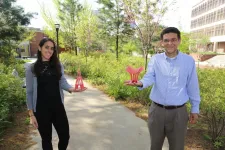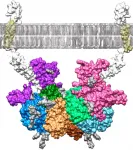(Press-News.org) Mass extinctions are known as times of global upheaval, causing rapid losses in biodiversity that wipe out entire animal groups. Some of the doomed groups linger on before going extinct, and a team of scientists found these "dead clades walking" (DCW) are more common and long-lasting than expected.
"Dead clades walking are a pattern in the fossil record where some animal groups make it past the extinction event, but they also can't succeed in the aftermath," said Benjamin Barnes, a doctoral student in geosciences at Penn State. "It paints the pictures of a group consigned to an eventual extinction."
The scientists found 70 of the 134 orders of ancient sea-dwelling invertebrates they examined could be identified as DCW in a new statistical analysis of the fossil record.
"What really fascinated us was that over half of all the orders we looked at have this phenomenon and that it can look like many different things," said Barnes, who led a group of graduate students and a postdoctoral researcher on the study. "In some cases, you have a group that has a sudden drop in diversity and lasts for a few more million years before disappearing from the record. But we also found many orders straggled along sometimes for tens or hundreds of millions of years."
The findings, published in the journal Proceedings of the National Academy of Sciences, challenge the view of extinction as a sudden disappearance and suggest that the full impact of mass extinctions lag behind the events themselves longer than previously expected, the scientists said.
"I think it raises questions about how the so-called kill mechanism operates," Barnes said. "We think of mass extinctions as being these selective forces that cause large groups of animals to go extinct, but our results really show there are a lot of instances where it's not so sudden. It raises questions about why that's such a long delay."
Paleontologist David Jablonski first coined the term DCW more than 20 years ago, and since then it has been associated almost exclusively with mass extinctions. Using a wealth of new fossil record data made available over the last two decades, the study found DCW are also common around smaller, more localized background extinction stages, the scientists said.
"Our results suggest that rather than representing a rare, brief fossil pattern in the wake of mass extinction events, DCWs are actually a really diverse phenomenon and that there might be a lot of drivers that produce this pattern in the fossil record," Barnes said. "These DCWs may represent a major macroevolutionary pattern."
The scientists used a statistical technique called a Bayesian change point algorithm to analyze fossil records from the Paleobiology Database, a public record of paleontological data maintained by international scientists.
The method allowed the researchers to search time series data for significant points where the data deviated from the pattern. They were able to identify negative jagged shifts in diversity and rule out that the organism went extinct immediately but instead persisted.
"So you might be looking in the fossil record and you'll find tons of a type of brachiopod," Barnes said. "Each order has a handful of families and dozens of genera within those families. Then you might see a drop in diversity, and the majority of those genera disappear and perhaps there's only one family that continues to survive."
Those survivors can continue in their niche for millions of years, even into the present. But their lack of diversity makes them more susceptible to future environmental challenges or extinction events, the scientists said.
"I think these findings cause you to reexamine how you measure success," Barnes said. "It's quite possible for an animal group not to produce new families and new genera at a rate like it did before, but if it continues to survive for many millions of years, that's still some form of success. I think it raises a lot of questions about what it means to be successful as a fossil organism and what ultimately are the controls of origination."
INFORMATION:
Barnes, the lead author on the study, is advised by Lee Kump, John Leone Dean in the College of Earth and Mineral Sciences and professor of geosciences at Penn State.
Judith A. Sclafani, a former graduate student at Penn State, and Andrew Zaffos, senior research scientist at Arizona State Geological Survey at Arizona University contributed to this work.
The observation that most of the viruses that cause human disease come from other animals has led some researchers to attempt "zoonotic risk prediction" to second-guess the next virus to hit us. However, in an Essay publishing April 20th in the open access journal PLOS Biology, led by Dr Michelle Wille at the University of Sydney, Australia with co-authors Jemma Geoghegan and Edward Holmes, it is proposed that these zoonotic risk predictions are of limited value and will not tell us which virus will cause the next pandemic. Instead, we should target the human-animal interface for intensive viral surveillance.
So-called zoonotic viruses ...
In many species, including humans and mice, the fluctuating levels of the hormones progesterone and estrogen determine whether the female is fertile or not. And in the case of mice, whether she's sexually receptive or not.
The change in receptivity is striking. Female mice shift from accepting sexual partners to aggressively rejecting them across a cycle of six short days. How can the female reproductive hormones bring about such a radical behavioural change?
When searching for an explanation, the team of Susana Lima, a principal investigator at the Champalimaud Centre for the Unknown in Portugal, came across an intriguing discovery.
"Our experiments revealed that a brain area important for female receptivity, called the VMH (ventromedial ...
A chemist from Purdue University has found a way to synthesize a compound to fight a previously "undruggable" cancer protein with benefits across a myriad of cancer types.
Inspired by a rare compound found in a shrub native to North America, Mingji Dai, professor of chemistry and a scientist at the Purdue University Center for Cancer Research, studied the compound and discovered a cost-effective and efficient way to synthesize it in the lab. The compound -- curcusone D -- has the potential to help combat a protein found in many cancers, including some forms of breast, brain, colorectal, prostate, lung and liver cancers, among others. The protein, dubbed BRAT1, had previously been deemed "undruggable" for its chemical properties. In collaboration with Alexander Adibekian's ...
Astronauts who spend extended time in space face stressors such as isolation, confinement, lack of privacy, altered light-dark cycles, monotony and separation from family. Interestingly, so do people who work at international research stations in Antarctica, where the extreme environment is characterized by numerous stressors that mirror those present during long-duration space exploration.
To better understand the psychological hurdles faced by astronauts, University of Houston professor of psychology Candice Alfano and her team developed the Mental Health Checklist (MHCL), a self-reporting instrument for detecting ...
A Texas A&M researcher is discovering the demographic characteristics that can produce or lessen stress for racial and ethnic minority students in school settings.
The study, recently published in the journal Ethnicity and Disease, collected mental health survey assessments among 389 sixth-graders from 14 Texas public schools in urban areas. Melissa DuPont-Reyes, assistant professor at the Texas A&M University School of Public Health, led the investigation of self-reported depressive-anxious symptoms over a two-year period. This issue of the journal highlighted research by early stage investigators, especially scholars of color, to advance new knowledge ...
A mollusk and shrimp are two unlikely marine animals that are playing a very important role in engineering. The bodies of both animals illustrate how natural features, like the structures of their bones and shells, can be borrowed to enhance the performance of engineered structures and materials, like bridges and airplanes. This phenomenon, known as biomimetics, is helping advance structural topology research, where the microscale features found in natural systems are being mimicked.
In a recent paper published by researchers at the Georgia Institute of Technology and the Pontifical Catholic University of Rio de ...
WASHINGTON, April 20, 2021 -- Fiber optic technology is the holy grail of high-speed, long-distance telecommunications. Still, with the continuing exponential growth of internet traffic, researchers are warning of a capacity crunch.
In AVS Quantum Science, by AIP Publishing, researchers from the National Institute of Standards and Technology and the University of Maryland show how quantum-enhanced receivers could play a critical role in addressing this challenge.
The scientists developed a method to enhance receivers based on quantum physics properties to dramatically increase network ...
Researchers at Johannes Gutenberg University Mainz (JGU) in Germany and the Institute of Molecular Biology of Barcelona in Spain have discovered how the blood plasma protein fetuin-B binds to the enzyme meprin β and used a computer model to visualize their findings. These results could lead to the development of new drugs to treat serious diseases such as Alzheimer's and cancer. Meprin β releases proteins from cell membranes, thus controlling important physiological functions in the human body. However, a dysregulation of this process can trigger the development of Alzheimer's and ...
Earthquake early warnings can be delivered successfully using a small network of off-the-shelf smartphones attached to building baseboards, according to a study conducted in Costa Rica last year.
In his presentation at the Seismological Society of America (SSA)'s 2021 Annual Meeting, Ben Brooks of the U.S. Geological Survey said the ASTUTI (Alerta Sismica Temprana Utilizando Teléfonos Inteligentes) network of more than 80 stations performed comparably to scientific-grade warning systems.
During six months' of ASTUTI operation, there were 13 earthquakes that caused noticeable ...
The famous 1700 Cascadia earthquake that altered the coastline of western North America and sent a tsunami across the Pacific Ocean to Japan may have been one of a sequence of earthquakes, according to new research presented at the Seismological Society of America (SSA)'s 2021 Annual Meeting.
Evidence from coastlines, tree rings and historical documents confirm that there was a massive earthquake in the U.S. Cascadia Subduction Zone on 26 January 1700. The prevailing hypothesis is that one megathrust earthquake, estimated at magnitude 8.7 to 9.2 and involving the entire tectonic plate boundary in the region, was responsible ...







